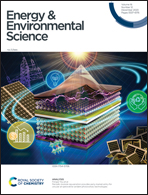Lead halide coordination competition at buried interfaces for low VOC-deficits in wide-bandgap perovskite solar cells†
Abstract
Perovskite tandem solar cells (TSCs) have promising prospects to break the efficiency limit of their single-junction solar cells. Wide-bandgap (WBG) perovskite sub cells as an essential component of perovskite TSCs face challenges in achieving high power conversion efficiency due to severe non-radiative charge recombination. Here, we propose an interfacial engineering strategy of sequentially depositing [2-(9H-carbazol-9-yl)ethyl]phosphonic acid and [4-(3,6-dimethyl-9H-carbazol-9-yl)butyl]phosphonic acid as a hole selective layer, which promotes hole extraction and suppresses the non-radiative recombination at the interface and in the bulk of the perovskite layer. The optimized WBG cells exhibit a remarkable VOC of 1.36 V, resulting in a record low VOC deficit of 0.42 V. Moreover, integrating these WBG perovskite sub cells into all-perovskite tandem cells gives rise to outstanding power conversion efficiencies of 27.34% and 28.05% for two-terminal and four-terminal TSCs, respectively. This research provides a unique perspective for the innovative preparation of highly efficient halide perovskites with high-quality buried interfaces.



 Please wait while we load your content...
Please wait while we load your content...